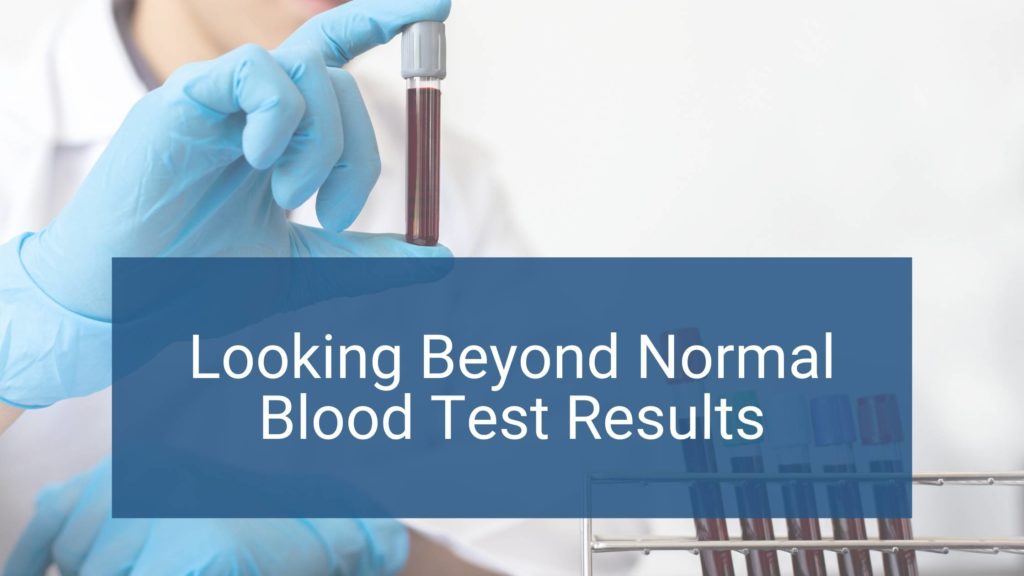How many clients have come to you after running bloodwork with their doctor and being told everything is “normal” when they feel the opposite? Blood tests don’t always tell you the whole story about what is going on with a person’s health. That’s why it’s important to do a functional blood chemistry analysis done by a practitioner who is trained in how to read and interpret the results from a functional standpoint.
How is functional blood chemistry different than the typical blood analysis?
Here is an example. Let’s say that there is a woman who we’ll call Jane. Jane has been dealing with some minor, but nagging health complaints such as fatigue and brain fog. These symptoms are mild, but have been getting worse and are starting to affect her life, so she schedules an appointment with her doctor. He proceeds to do a basic blood chemistry panel on her. When the results come back, her doctor informs her that there is nothing wrong with her. This is because everything on the tests came back in the normal reference range.
But Jane knew better. Her fatigue and brain fog are not normal and she senses she is not fine. Something is not functioning properly in her body and it’s time for her to seek out the help of someone who can really make a difference – a Functional Diagnostic Nutrition® Practitioner.
There is no difference in the blood test itself, but there is a big difference in how the test is interpreted. When it comes to blood chemistry analysis, there are two ranges that can be looked at and analyzed. The Pathological and the Functional range.
The Pathological range is the range most commonly looked at by allopathic doctors. This range indicates a level of disease in the body. It tends to be a very wide range, with focus going to markers in the high and low areas of the range.
The Functional range is the range we want to compare ourselves and our clients to as it relates to the optimal range in which someone will feel their best.

The frustration of focusing only on the Pathological range…
So, like we saw with Jane, if the test results fall within the bounds of “normal” Pathological range, and don’t indicate disease, then it is likely that a doctor will tell his patient that there is nothing wrong. That can leave a patient frustrated, without answers and still feeling unwell. As a result, your clients may come to you looking for advice on what to do next.
The Functional range varies from the Pathological range – It is a much narrower range than the Pathological range. Although much of this range is considered by many doctors to be normal, this range can show more subtle signs that disease and dysfunction are starting in the body. It can be used to gauge the risk of a disease developing before the disease actually occurs. In the FDN® Certification Course you are taught to interpret test results from a functional perspective and gain deeper insight as to what is going on with your client and how to help.

The “normal” range
The Functional range that is considered “normal” by many doctors in fact may be giving indication that the body is out of balance. If left unchecked, disease will be the outcome. But when looking at the Functional range, a practitioner, like an FDN-P who can interpret subtle variations and patterns of beginning dysfunction, can often work with a client to prevent the onset of disease and reverse symptoms.
This preventative work can be done through appropriate diet, exercise, stress management, quality sleep, proper supplementation and other non-invasive natural therapies and modalities. Functional Diagnostic Nutrition® Practitioners use these basic health building principles to outperform specific treatments with their training on how to help their clients D.R.E.S.S. for Health Success®.
Unfortunately, our current model of healthcare is not setup for the prevention of disease, but for the treatment of disease. The majority of doctors aren’t looking for the factors that could lead to disease while interpreting a blood chemistry panel. They are looking for the markers that disease is already occurring in the body.

Remember our friend Jane?
After the frustration of being told that there is nothing wrong with her, she contacted an FDN Practitioner who was trained in Functional Blood Chemistry analysis. Jane shared her blood chemistry test results with her practitioner, who easily spotted some patterns within some of the blood chemistry markers that showed that there was indeed dysfunction occurring in her body.
Her FDN Practitioner worked closely with her, helping her to recognize what dietary changes she needed to make to support healing in her body. They uncovered some of the hidden stressors in her body. She started on a good exercise program and began sleeping better. Plus, she began taking the right supplements to support what her body needed to heal and function optimally. Within a few weeks, Jane was beginning to feel better. Her fatigue and brain fog began to diminish and her energy and vitality increased.
Both lab ranges are important
Both ranges are important and serve their purpose. If someone truly is in a state of disease, the Pathological range will help a doctor to identify that. But the Functional range also needs to be considered. It is this range that will help you to know if dysfunction is beginning. And it will allow you to start taking the steps to reverse that dysfunction….before it becomes a chronic disease state for your client.
You too can become trained on how to use functional lab testing to help clients on a deeper level with a certification from Functional Diagnostic Nutrition®.








